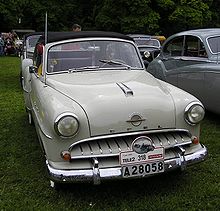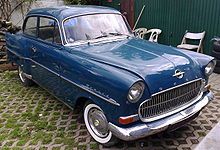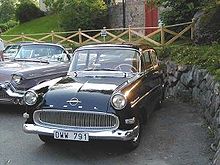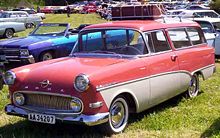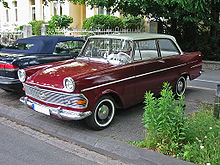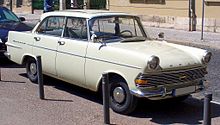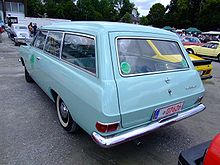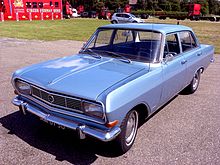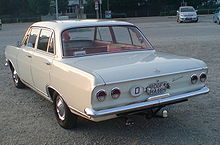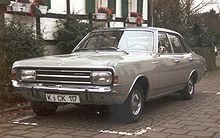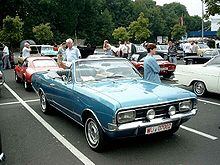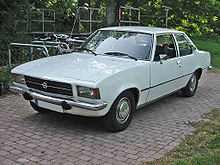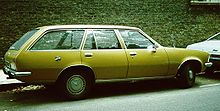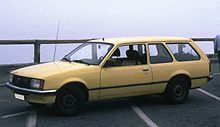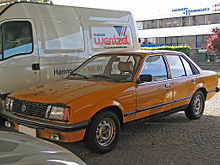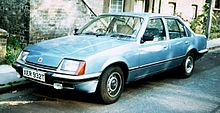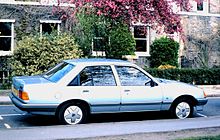- Opel Rekord
-
"Rekord" redirects here. For other uses, see Record (disambiguation).
Opel Rekord 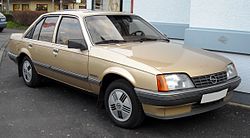
Manufacturer Opel Production 1953–1986 Predecessor Opel Olympia Successor Opel Omega Class large family car (1953–1972),
executive car (1972–1986)Body style 4-door saloon,
2-door saloon,
3-door station wagon,
5-door station wagon,
3-door van,
2-door convertibleThe Opel Rekord was a large family car/executive car which was built in several generations by the German car manufacturer Opel.
Contents
Naming
The Rekord name evolved into the main name of the model; at first the name was used in close relationship with the Opel Olympia name, which pre-dated the Rekord but was also re-instated in a separate model in 1967.
The various generations are described here with the manufacturer's, or other commonly used designations such as "Rekord P I" or "Rekord B". The car was not marketed with these additional appellations.
Opel Olympia Rekord (1953–57)
The Opel Olympia Rekord was introduced in March 1953 as successor to the Opel Olympia, a pre-World War II design dating back to 1935. The Opel Olympia Rekord was built until 1957 in four different versions. Around 580,000 units were produced.
- 1953/54: 1488 cc, 40 hp (DIN). Available as two-door saloon, cabriolet and estate (Caravan). Price in Germany: DM 6,410 to 6,710. 136,028 units made.
- 1955: 1488 cc, 40 hp (DIN). Mild facelift, comprising larger rear window, new grill insert. New base model called simply Olympia; a van based on the saloon introduced as the "delivery" variant. Price in Germany: DM 5,850 to 6,710. 131,586 units made.
- 1956: 1488 cc, 45 hp (DIN). New grill insert, bumpers now without guards. Price in Germany: DM 5,410 to 6,560. 144,587 units made.
- 1957: 1488 cc, 45 hp (DIN). New grill insert again, flatter roof, chrome strips along belt line. The cabriolet was no longer part of the line. Prices in Germany: DM 5,510 to 6,560. 169,721 units made.
General data:
- Wheelbase 97.9 in (2,487 mm)
- Length 166.9 in (4,239 mm)
- Width 64 in (1,626 mm)
- Height 61 in (1,549 mm)
- Kerb weight 2,020 lb (920 kg)-2,200 lb (1,000 kg)
- Top speed approximately 75 mph (121 km/h)
Opel Rekord P I (July 1957 – July 1960)
The Opel Rekord P I had a slightly larger, more modern body with wraparound windscreen and rear screen, introducing to Germany the latest American fashion of two-tone paintwork.[1]
The standard model was sold as the Opel Olympia Rekord, while a reduced specification version was marketed simply as the Opel Olympia and widely known, less formally, as the "Bauern-Buick" (Peasant's Buick).[1]
A new base version with an 1196 cc engine appeared in 1959 badged more simply as the Opel 1200, and replacing the Opel Olympia.
A semi-automatic gearbox ("Olymat") became available for model year 1959. Initially the car retained the 1488 cc, 45 hp (DIN) of its predecessor: this was complemented by a 1680 cc, 55 hp (DIN);L engine[1] for model year 1960.
The PI remained in production until 1960.
- 1958–59: 1488 cc, 45 hp (DIN). Available as two-door "Olympia" base model or more luxurious two-door "Olympia Rekord" and as three-door estate ("Caravan") and "delivery" van based on the saloon. Price in Germany: DM 5,785 to 6,845. 509,110 units were made.
- 1959: 1488 cc, 45 hp (DIN); on request 1680 cc, 55 hp (DIN). Also available as four-door saloon. Several refinements including padded dashboard, ignition lock, electrically driven windscreen wipers. The new base model "Opel 1200" replaced the former Olympia (1196 cc, 40 hp (DIN), DM 5,835); the 1200 remained in production until December 1962, while the P I was superseded in August 1960 by the Rekord P II.
Price in Germany: DM 6,545 to 7,110. 307,000 units (P I) + 67.952 units (1200). In 1959–60, Autenrieth of Darmstadt, Germany converted P I two-door sedans to coupés and cabriolets, in very limited numbers. Prices were DM 9,380 for the coupé and DM 11,180 for the convertible.
General data:
- Wheelbase 100 in (2,540 mm)
- Length 174.9 in (4,442 mm)
- Width 63.6 in (1,615 mm)
- Height 58.7 in (1,491 mm)
- Kerb weight 2,010 lb (910 kg)-2,210 lb (1,000 kg)
- Top speed 74 mph (119 km/h)–82 mph (132 km/h).
Opel Rekord P II (1960–63)
The Rekord P II grew in size, if not in wheelbase, and received a totally new body that did away with wraparound windows. It was available in several body versions: 2-door and 4-door saloon, a 3-door estate ("Caravan") plus delivery van, a pick-up, and a convertible. From August 1961 on, a works coupé became available, and in June 1962 a more luxurious "L" version was added with a new top engine of 1700 cc "S" and a higher compression ratio. The latest versions had an optional four-speed gearbox.
Prices in Germany: DM 6,545 to 7,770. 787,684 units made. Autenrieth continued to sell a handful of convertibles at DM 11,635.
General data:
- Engines: 1488 cc, 50 hp (DIN), or 1680 cc, 55 hp (DIN) or 1680 cc, 60 hp (DIN)
- Wheelbase 100 in (2,540 mm)
- Length 177.8 in (4,516 mm)
- Width 64.3 in (1,633 mm)
- Height 58.6 in (1,488 mm)
- Kerb weight 2,075 lb (941 kg)-2,240 lb (1,020 kg)
- Top speed 77 mph (124 km/h)-87 mph (140 km/h)
Opel Rekord A (1963–65)
The Rekord A line-up was a repeat of the Rekord P II (two- and four-door saloon, two-door estate and delivery van, two-door coupé with 1500 or 1700 or 1700 S engines), but the bodies were completely new and the wheelbase stretched to 103.3 inches (2,620 mm). March 1964 saw the introduction of the Rekord L-6 with the Opel Kapitän's 2.6 litre inline-six.
Prices in Germany: DM 6.830 to 9.370; front disc brakes: + DM 200, four-speed with floor shift: + DM 180. 885,292 units. In very limited numbers, Karl Deutsch of Cologne sold a convertible version with either 1700 S or 2600 engine at DM 11,765 and 13,060 respectively.
General data:
- Engines: 1488 cc, 55 hp (DIN), or 1680 cc, 60 or 67 hp (DIN), or 2605 cc, 100 hp (DIN)
- Wheelbase 103.9 in (2,639 mm)
- Length 178 in (4,521 mm)
- Width 66.8 in (1,697 mm)
- Height 57.7 in (1,466 mm)
- Kerb weight 2,140 lb (970 kg)-2,510 lb (1,140 kg)
- Top speed 81 mph (130 km/h)-104 mph (167 km/h)
Opel Rekord B (1966–67)
While the Rekord B consisted of only a mild facelift compared to the A, it received Opel's new, more oversquare four cylinder CIH (cam in head) engines (1500, 1700 S, 1900 S). The CIH engines were used in all subsequent Rekord generations until 1986, when Rekord was replaced by the Opel Omega. The 2600 cc six-cylinder engine remained unchanged. The line-up was identical to the Rekord A.
Prices in Germany: DM 6,980 to 9,570; power brakes: + DM 95, automatic gearbox: + 950, four speed gearbox: + 95. 296,771 units.
General data:
- Engines: 1492 cc, 60 hp (DIN), or 1698 cc, 75 hp (DIN), or 1897 cc, 90 hp (DIN), or 2605 cc, 100 hp (DIN)
- Wheelbase 103.9 in (2,639 mm)
- Length 178.3 in (4,529 mm)
- Width 66.6 in (1,692 mm)
- Height 56.7 in (1,440 mm)
- Kerb weight from 2,190 lb (990 kg)
- Top speed 83 mph (134 km/h)-104 mph (167 km/h)
Opel Rekord C (1967–71)
Opel Rekord C 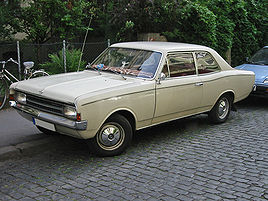
Production 1967–1971 Predecessor Opel Rekord B Successor Opel Rekord D Class Full-size Body style 2-door sedan
4-door sedan
5-door stationwagon
2-door coupe
3-door vanLayout FR layout Transmission 3-speed manual
4-speed all-synchromesh manual
3-speed automaticWheelbase 105 in (2,700 mm) Length 181 in (4,600 mm) Width 69.25 in (1,759 mm) Height 56.1 in (1,420 mm) Related Opel Commodore
Chevrolet Opala
Holden MonaroWith 1,276,681 units built, the Rekord C was the most successful Rekord so far. The car proved to be a solid hit with the public: it was reliable, roomy and pleasant to look at with its coke-bottle line.
The range consisted of the two- and four-door saloon, two- and (new) four-door estate, delivery van, and two-door hardtop coupé with 1500, 1700, 1700 S, 1900 S fours or (until 1968) a 2200 six. Very short-lived (1967 only) was a special taxi version on a longer wheelbase (113 inch) with division, that sold for DM 9,950; with it, Opel tried to get a foothold in the German taxi market, then (as now) dominated by Mercedes-Benz. Again, Karl Deutsch of Cologne offered a convertible version in limited numbers.
There existed several variations of the Rekord C, as well as version made under different names in different countries.
A variation on the Rekord C was the Rekord Sprint coupé (1967–71) with driving lights, sport steel wheels, sport stripes and a sporty interior; the Sprint received exclusively the so-called 1900 H engine with two double-barrel carburettors, good for 106 hp (DIN) and 108 mph (174 km/h).
The former Rekord L-6 was replaced by the new Commodore A, a slightly disguised and better-equipped Rekord C available as two- and four-door sedan and hardtop coupé with six cylinder engines only.
It was during the life of this model (in fact 1967–70) that the Opel Olympia name was revived, but in a separate, smaller car which was based on the period Opel Kadett.
Due to the launch of the smaller Ascona in September 1970, the Rekord was marketed as an executive car rather than a large family car.
Ranger
The Ranger was a Rekord-based range built at the Opel Continental plant in Antwerp, Belgium, for the overall European market. Styling was similar to the Rekord, although the Ranger had a four-headlamp grille setup, similar to the Vauxhall Victor FD range of the time. Initially, there were two models: Ranger 130 and Ranger 153. In 1970 additional models were announced, being the Ranger 1900 and Ranger 2500, and a "SS" variant, based on the Ranger 153.
There was also a South African Ranger, built in General Motors South Africa's plant Port Elizabeth. Known as 'South Africa's Own Car', it featured a springbok logo on its grille, and was also produced as a station wagon.
Other markets
The Rekord C was built Chevrolet Opala and Comodoro in Brazil from 1968 on, available in saloon, coupé and estate forms and featuring either Chevrolet's 2.5 L four or 4.1 L inline-six. These models received several facelifts and remained in production until about 1992.
A Rekord C coupé was locally-built in South Africa as a Chevrolet SS during the 1970s.[2]
Prices in Germany (1966): DM 7,630 to 9,560; Sprint (1967): DM 9,775.
The Rekord C was the only Opel model to ever be marketed in Mexico as Opel; Corsa, Astra and others were sold under Chevrolet during the 1990s and first decade of the 21st century.
General data:
- Engines: 1492 cc, 58, later 60 hp (DIN), 1698 cc, 60, later 66 hp (DIN), 1698 cc, 75 hp (DIN), 1897 cc, 90 hp (DIN), 1897 cc, 106 hp (DIN), 2239 cc, 95 hp (DIN)
- Wheelbase 105 in (2,667 mm)
- Length 180 in (4,572 mm)
- Width 69.1 in (1,755 mm)
- Height 57.5 in (1,461 mm)
- Kerb weight 2,265 lb (1,027 kg)-2,585 lb (1,173 kg)
- Top speed 81 mph (130 km/h)-108 mph (174 km/h)
Opel Rekord D (1972–77)
Opel Rekord D 
Also called Chevrolet Iran (IR)[3]
Shinjin Record (ROK)
Ranger 1700 (CH / ZA / B)
Ranger 1900 (CH / ZA / B)
Ranger 2500 (CH / ZA / B)Production 1972–1977 Predecessor Opel Rekord C Successor Opel Rekord E Class Full-size Body style 2-door sedan
4-door sedan
5-door stationwagon
2-door coupe
3-door vanLayout FR layout Wheelbase 105 in (2,700 mm) Length 179.75 in (4,566 mm) Width 67.375 in (1,711.3 mm) Height 55.375 in (1,406.5 mm) Related Opel Commodore,
Vauxhall Victor FEAbout 1.1 million Rekord Ds were made. Because the name Rekord D was easily mistaken to connote a diesel-powered car, the name Rekord II was often used in sales literature. The first prototype was ready in 1971. The engine types available were 1897 cc, 1698 cc and 2068 cc CIH (cam-in-head) four-cylinder gasoline engines. There was also a diesel version with an engine whose displacement was initially 2.1 litres and afterwards reduced to 2.0 litres. The diesel engine was higher than gasoline variants, so diesel model hoods have a raised mid-section. The six-cylinder variant of this car is called the Commodore B. Transmissions available were standard four-speed manual with either floor or steering-column shifter and TH-180 automatic transmission. The body is of unitary construction. Body types available were four-door saloon, four-door estate and two-door coupé. There was also a variant called "Berlina" with more luxurious interior and wheels.
The Rangers were also transferred to this new generation, with the dropping of the 130 and 153 and the adding of a 1.7 L engine. In 1972, the line-up consisted of the base Ranger 1700, the mid-level Ranger 1900, and the top-of-the-line Ranger 2500. In 1974, a 2.8L engine was introduced to the Ranger family. However, by that time the Rangers were unpopular, and were discontinued after the 1976 model year. Most of these were sold exclusively in Continental Europe, especially the Benelux region.
South Africa used this body type for their Chevrolet 2500, 3800 and 4100 series. They looked visually almost identical but had the Chevrolet 2500 (4 cylinder) or 3800 and 4100 (6 cylinder) engines installed. They were available as four door saloon or estate. The six cylinder versions could be differentiated from the "fours" as they had four round headlights as opposed to the two rectangular units.
These cars were also assembled in Iran (before revolution) from 1974 till 1977 under the local "Chevrolet Royale / or Chevrolet Iran" brand-name by Iran General Motors. The two models were 2500 and 2800 with 2.5L and 2.8L, respectively.The production of these vehicles ended in 1977 when the assembly line started producing the Chvrolet Nova, Buick Skylark, and Cadillac Seville cars until 1987.
Opel Rekord E (1977–86)
Opel Rekord E 
Also called Chevrolet Rekord (ZA)
Shinjin Record Royale (ROK)Production 1977–1986 Predecessor Opel Rekord D Successor Opel Omega Class Full-size Body style 2-door sedan
4-door sedan
3-door station wagon, van
5-door station wagonLayout FR layout Related Holden Commodore
Opel Commodore
Vauxhall Carlton
Vauxhall ViceroyThe E model can be subdivided into Rekord E1 (1977–82) and Rekord E2 (1982–86). Over 1.4 million units were made. The Rekord E was available as a two- or four-door sedan, and as a three- or five-door Caravan (station wagon). In some markets where the tax structure was suitable, a three-door van version was also available.
A version of the EI was sold by Vauxhall in the United Kingdom from 1979 as the Carlton, which featured the distinct slanted front end shared with the Chevette and Cavalier. The Carlton quietly succeeded the (by then long since discontinued) Vauxhall Victor FE, and was joined by the short lived Vauxhall Viceroy, a rebadged Commodore C. In the UK both models were outsold by the Ford Granada.
After the release of the E2 in 1982, Vauxhall Carltons were distinguishable from Opel Rekords only by their badging, with no sheet metal changes. Models sold in the UK had 2.0 L petrol and 2.3 L diesel engines in base, Berlina and Berlina S trim levels, and were all available with either a four-speed manual or a three-speed automatic transmission. In mainland Europe a host of different engines were available, ranging from a 1.7 L to a 2.2 L petrol and also including a 2.0 L diesel for countries such as Italy, where larger engines were heavily taxed. The diesel engines were taller and necessitated a distinctive bonnet with a large hump in it. Diesel Rekords were particularly popular in France, Italy, and the Benelux countries.
The Rekord EI was the basis of the original 1978 Holden VB Commodore. However, to cope with Australian conditions it was strengthened substantially and used the Senator's nose (like the Opel Commodore) to accommodate the Holden straight-6 and V8 engines.
In South Africa the model was sold as a Chevrolet until 1982, when it was rebadged as an Opel. South African Rekords originally received a small bore version of GM's venerable Iron Duke four-cylinder engine, of 2,320 cc and 90 PS (66 kW) at 4,800 rpm.[4] The facelifted EII versions received the 1,979 cc four as used in Europe, with 100 PS (74 kW) (110 PS/81 kW for the fuel injected version).[5] Delta Motor Corporation, which bought out GM's South African subsidiary after it divested from the country in 1986, produced the EII model until the early 1990s. Later South African Rekords featured the Opel badge above the grille, similar to the smaller Kadett.
A version of the Rekord, known as the Royale, was produced by Daewoo in South Korea, featuring the front end of the larger Senator. This should not be confused with the Vauxhall Royale, which was effectively a rebadged Opel Monza/Opel Senator. Bodies for the Daewoo came from Holden in Australia.
UK Models
Type Saloon Estate Engine Years Av. Rekord X - 2.0 1978–80 Rekord DL - X 2.0 1978–80 Rekord Berlina, HL X - 2.0 1978–80 Rekord S X X 2.0 1980–82 Rekord Berlina S X - 2.0 1980–82 Rekord Berlina CD X - 2.0 1978–82 Rekord Diesel DL X X 2.3D 1978–80 Rekord Diesel X X 2.3D 1980–82 References
- ^ a b c "Modellchronik des Opel Rekord von 1953 bis 1960". Auto Motor u. Sport Heft 24 1977: Seite 58. 23 November 1977.
- ^ Chevrolet SS – a History
- ^ http://web.parskhodro.ir/pdf/Parskhodro%20history.pdf
- ^ Braunschweig, Robert; Büschi, Hans-Ulrich, eds (March 6, 1980). Automobil Revue '80. 75. Berne, Switzerland: Hallwag, AG. p. 231.
- ^ World Cars 1985. Pelham, NY: The Automobile Club of Italy/Herald Books. 1985. p. 332. ISBN 0-910714-17-7.
External links
- http://www.opel-p1.nl/ Opel P1 websites
- Opel Rekord.
- Opel Rekord Body History.
- GM Trivia, GMInsideNews Forums.
- Classic Opel Parts database
Opel Current Opel
passenger carsCurrent Opel
commercial vehiclesHistoric and
discontinued modelsAdmiral • Arena • Ascona • Bedford Blitz • Blitz • Calibra • Campo • Chevette • Commodore • Diplomat • 5/12 PS "Puppchen" • 4/8 PS "Doktorwagen" • Frontera • GT • Kadett • Kapitän • Laubfrosch • Manta • Monterey • Monza • Olympia • Omega • Patentmotorwagen „System Lutzmann“ • P4 • RAK • RAK1 • RAK2 • Regent • Rekord • Senator • Signum • Sintra • Speedster • Super 6 • Tigra • 10/30 (10/35) PS • 12,3-Liter-Rennwagen • VectraMotor racing cars Concept cars Divisions and
subsidiariesOpel Eisenach GmbH • Opel Motoren Kaiserslautern GmbH • Opel Powertrain GmbH • Opel Performance Center GmbH • Opel Special Vehicles GmbHOther Founder: Adam Opel • Opel InternationalOpel road car timeline, 1947–1970s next » Type 1940s 1950s 1960s 1970s 7 8 9 0 1 2 3 4 5 6 7 8 9 0 1 2 3 4 5 6 7 8 9 0 1 2 3 4 5 6 7 8 9 Small family car Kadett A Kadett B Kadett C Olympia Olympia Rekord Olympia A Large family car Rekord PI Rekord PII Ascona A Ascona B Executive car Rekord A Rekord B Rekord C Rekord D Rekord E Kapitän Kapitän Kapitän PI / PII Commodore A Commodore B Commodore C Luxury car Kapitän A / Admiral A / Diplomat A Kapitän B / Admiral B / Diplomat B Senator / Monza Coupé / Roadster GT Manta A Manta B « previous — Opel road car timeline, 1980s–present Type 1980s 1990s 2000s 2010s 0 1 2 3 4 5 6 7 8 9 0 1 2 3 4 5 6 7 8 9 0 1 2 3 4 5 6 7 8 9 0 City car Agila A Agila B Supermini Corsa A Corsa B Corsa C Corsa D Compact car Kadett C Kadett D Kadett E Astra F Astra G Astra H Astra J Large family car Ascona B Ascona C Vectra A Vectra B Vectra C Insignia Signum Executive car Rekord E/ Commodore C Omega A Omega B Luxury car Senator A/ Monza Senator B Sports car Tigra Tigra TwinTop Manta B Calibra Speedster GT Mini MPV Meriva A Meriva B Compact MPV Zafira A Zafira B Large MPV Sintra SUV Frontera A Frontera B Antara Monterey LCVs Combo B Combo C Arena Vivaro Movano Movano Categories:- Opel vehicles
- Sedans
- Station wagons
- Executive cars
- Rear wheel drive vehicles
- Vehicles introduced in 1953
- 1950s automobiles
- 1960s automobiles
- 1970s automobiles
- 1980s automobiles
Wikimedia Foundation. 2010.

